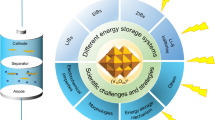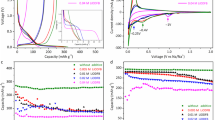Abstract
Lithium-ion batteries (LIBs) have been used to power various electric devices and store energy, but their toxic components by using inorganic materials generally cause serious environmental issues when disused. Recently, environmentally friendly and naturally abundant organic compounds have been adopted as promising electrode materials for next-generation LIBs. Herein, a new organic anode electrode based on sodium citrate is proposed, which shows gradually activated electrochemical behavior and delivers a high reversible capacity of 776.8 mAh·g−1 after 1770 cycles at a current density of 2 A·g−1. With the aid of the electrochemical characterization, Fourier-transform infrared (FTIR) and X-ray photoelectron spectroscopy (XPS) analysis, the lithium uptake mechanism of sodium citrate-based anodes is identified to be a combination of three-electron lithiation/delithiation and fast Li+ intercalation/deintercalation processes, in which Faradaic reactions could offer a theoretical contribution of 312 mAh·g−1 and intercalation pseudocapacitance would provide extra capacity. This work demonstrates the great potential for developing high-capacity organic electrodes for LIBs in future.
Graphic abstract





Similar content being viewed by others
References
Tang L, He YB, Wang C, Wang S, Wagemaker M, Li BH, Yang QH, Kang FY. High-density microporous Li4Ti5O12 microbars with superior rate performance for lithium-ion batteries. Adv Sci. 2017;4(5):1600311.
Armand M, Grugeon S, Vezin H, Laruelle S, Ribiere P, Poizot P, Tarascon JM. Conjugated dicarboxylate anodes for Li-ion batteries. Nat Mater. 2009;8:120.
Guo Y, Qin GH, Liang EQ, Li MW, Wang CY. MOFs-derived MgFe2O4 microboxes as anode material for lithium-ion batteries with superior performance. Ceram Int. 2017;43(15):12519.
Li R, Wang LX, An HY, Zhang FQ. Study of lithium/polypyrrole secondary batteries with lithium as cathode and polypyrrole anode. Rare Met. 2007;26(6):591.
Li T, Liu H, Shi P, Zhang Q. Recent progress in carbon/lithium metal composite anode for safe lithium metal batteries. Rare Met. 2018;37(6):449.
Ma Z, Zhuang YC, Deng YM, Song XN, Zuo XX, Xiao X, Nan JM. From spent graphite to amorphous sp2 + sp3 carbon-coated sp2 graphite for high-performance lithium ion batteries. J Power Sources. 2018;376:91.
Jin YT, Kneusels NH, Magusin P, Kim GW, Castillo-Martinez E, Marbella LE, Kerber RN, Howe DJ, Paul S, Liu T, Grey CP. Identifying the structural basis for the increased stability of the solid electrolyte interphase formed on silicon with the additive fluoroethylene carbonate. J Am Chem Soc. 2017;139(42):14992.
Jiang J, Zhang H, Zhu JH, Li LP, Liu YN, Meng T, Ma L, Xu MW, Liu JP, Li CM. Putting nanoarmors on yolk–shell Si@C nanoparticles: a reliable engineering way to build better Si-based anodes for Li-ion batteries. ACS Appl Mater Interfaces. 2018;10(28):24157.
Wu ZH, Yang JY, Yu B, Shi BM, Zhao CR, Yu ZL. Self-healing alginate–carboxymethyl chitosan porous scaffold as an effective binder for silicon anodes in lithium-ion batteries. Rare Met. 2019;38(9):832.
Yuan TZ, Jiang YZ, Sun WP, Xiang B, Li Y, Yan M, Xu B, Dou SX. Ever-increasing pseudocapacitance in RGO-MnO-RGO sandwich nanostructures for ultrahigh-rate lithium storage. Adv Funct Mater. 2016;26(13):2198.
Zhang WY, Zhang BY, Jin HX, Li P, Zhang YJ, Ma SY, Zhang JX. Waste eggshell as bio-template to synthesize high capacity δ-MnO2 nanoplatelets anode for lithium ion battery. Ceram Int. 2018;44(16):20441.
Padhy H, Chen YQ, Lüder J, Gajella SR, Manzhos S, Balaya P. Charge and discharge processes and sodium storage in disodium pyridine-2,5-dicarboxylate anode-insights from experiments and theory. Adv Energy Mater. 2018;8(7):1701572.
Wu YW, Zeng RH, Nan JM, Shu D, Qiu YC, Chou SL. Quinone electrode materials for rechargeable lithium/sodium ion batteries. Adv Energy Mater. 2017;7(24):1700278.
Zhao Q, Zhu ZQ, Chen J. Molecular engineering with organic carbonyl electrode materials for advanced stationary and redox flow rechargeable batteries. Adv Mater. 2017;29(48):1607007.
Häupler B, Wild A, Schubert US. Carbonyls: powerful organic materials for secondary batteries. Adv Energy Mater. 2015;5(11):1402034.
Peng CX, Ning GH, Su J, Zhong GM, Tang W, Tian BB, Su CL, Yu DY, Zu LH, Yang JH, Ng MF, Hu YS, Yang Y, Armand M, Loh KP. Reversible multi-electron redox chemistry of π-conjugated N-containing heteroaromatic molecule-based organic cathodes. Nat Energy. 2017;2:17074.
Zhu ZQ, Chen J. Review-advanced carbon-supported organic electrode materials for lithium (sodium)-ion batteries. J Electrochem Soc. 2015;162(14):A2393.
Jing Y, Liang YL, Gheytani S, Yao S. Cross-conjugated oligomeric quinones for high performance organic batteries. Nano Energy. 2017;37:46.
Ma T, Zhao Q, Wang JB, Pan Z, Chen J. A sulfur heterocyclic quinone cathode and a multifunctional binder for a high-performance rechargeable lithium-ion battery. Angew Chem Int Ed. 2016;55(22):6428.
Schon TB, McAllister BT, Li PF, Seferos DS. The rise of organic electrode materials for energy storage. Chem Soc Rev. 2016;45(22):6345.
Zhao Q, Guo CY, Lu Y, Liu LJ, Liang J, Chen J. Rechargeable lithium batteries with electrodes of small organic carbonyl salts and advanced electrolytes. Ind Eng Chem Res. 2016;55(20):5795.
Wang SQ, Wang LJ, Zhang K, Zhu ZQ, Tao ZL, Chen J. Organic Li4C8H2O6 nanosheets for lithium-ion batteries. Nano Lett. 2013;13(9):4404.
Lei ZS, Yang QS, Xu Y, Guo SY, Sun WW, Liu H, Lv LP, Zhang Y, Wang Y. Boosting lithium storage in covalent organic framework via activation of 14-electron redox chemistry. Nat Commun. 2018;9:576.
Man ZM, Li P, Zhou D, Zang R, Wang SJ, Li PX, Liu SS, Li XM, Wu YH, Liang XH, Wang GX. High-performance lithium–organic batteries by achieving 16 lithium storage in poly(imine-anthraquinone). J Mater Chem A. 2019;7(5):2368.
Liu GY, Zhao LF, Sun RX, Chen WH, Hu M, Liu M, Duan XY, Zhang TM. Mesoporous TiNb2O7 microspheres as high performance anode materials for lithium-ion batteries with high-rate capability and long cycle-life. Electrochim Acta. 2018;259:20.
Zhan C, Lian C, Zhang Y, Thompson MW, Xie Y, Wu JZ, Kent PR, Cummings PT, Jiang DE, Wesolowski DJ. Computational insights into materials and interfaces for capacitive energy storage. Adv Sci. 2017;4(7):1700059.
Luo JM, Zhang WK, Yuan HD, Jin CB, Zhang LY, Huang H, Liang C, Xia Y, Zhang J, Gan YP, Tao XY. Pillared structure design of MXene with ultralarge interlayer spacing for high-performance lithium-ion capacitors. ACS Nano. 2017;11(3):2459.
Wang XF, Shen GZ. Intercalation pseudo-capacitive TiNb2O7@carbon electrode for high-performance lithium ion hybrid electrochemical supercapacitors with ultrahigh energy density. Nano Energy. 2015;15:104.
Li HX, Lang JW, Lei SL, Chen JT, Wang KJ, Liu LY, Zhang TY, Liu WS, Yan XB. A High-performance sodium-ion hybrid capacitor constructed by metal-organic framework-derived anode and cathode materials. Adv Funct Mater. 2018;28(30):1800757.
Chen D, Tan HT, Rui XH, Zhang Q, Feng YZ, Geng HB, Li CC, Huang SM, Yu Y. Oxyvanite V3O5: a new intercalation-type anode for lithium-ion battery. InfoMat. 2019;1(2):251.
Hu ZL, Sayed S, Jiang T, Zhu XY, Lu C, Wang GL, Sun JY, Rashid A, Yan CL, Zhang L, Liu ZF. Self-assembled binary organic granules with multiple lithium uptake mechanisms toward high-energy flexible lithium-ion hybrid supercapacitors. Adv Energy Mater. 2018;8(30):1802273.
Luo C, Huang RM, Kevorkyants R, Pavanello M, He HX, Wang CS. Self-assembled organic nanowires for high power density lithium ion batteries. Nano Lett. 2014;14(3):1596.
Li BQ, Kong L, Zhao CX, Jin Q, Chen X, Peng HJ, Qin JL, Chen JX, Yuan H, Zhang Q, Huang JQ. Expediting redox kinetics of sulfur species by atomic-scale electrocatalysts in lithium-sulfur batteries. InfoMat. 2019;1(4):533.
Acknowledgements
This study was financially supported by the National Natural Science Foundation of China (Nos. 21875155, 51675275 and 21473119) and the Scientific and Technological Research Program of Chongqing Municipal Education Commission (No. KJQN201900527). The authors acknowledge the support from the Key Laboratory for Advanced Carbon Materials and Wearable Energy Technologies of Jiangsu Province, Suzhou, China.
Author information
Authors and Affiliations
Corresponding authors
Rights and permissions
About this article
Cite this article
Long, R., Wang, GL., Hu, ZL. et al. Gradually activated lithium uptake in sodium citrate toward high-capacity organic anode for lithium-ion batteries. Rare Met. 40, 1366–1372 (2021). https://doi.org/10.1007/s12598-020-01502-5
Received:
Revised:
Accepted:
Published:
Issue Date:
DOI: https://doi.org/10.1007/s12598-020-01502-5




